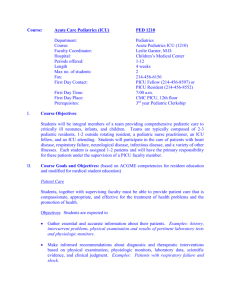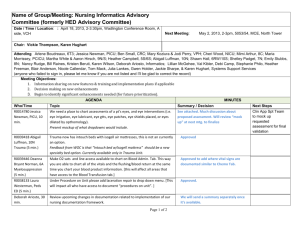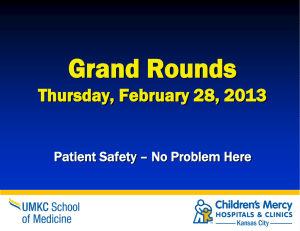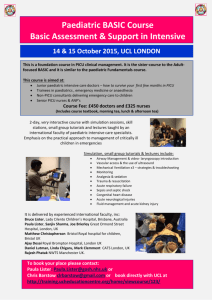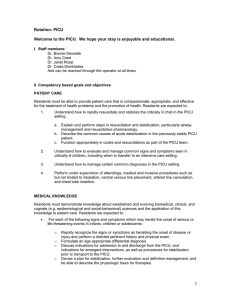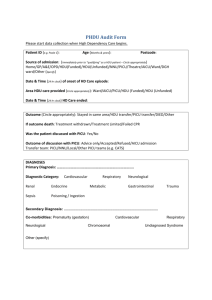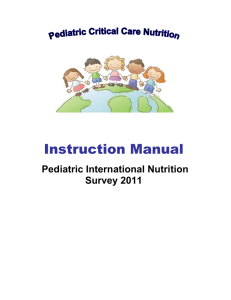CHNOLA Pediatric Intensive Care Unit
advertisement
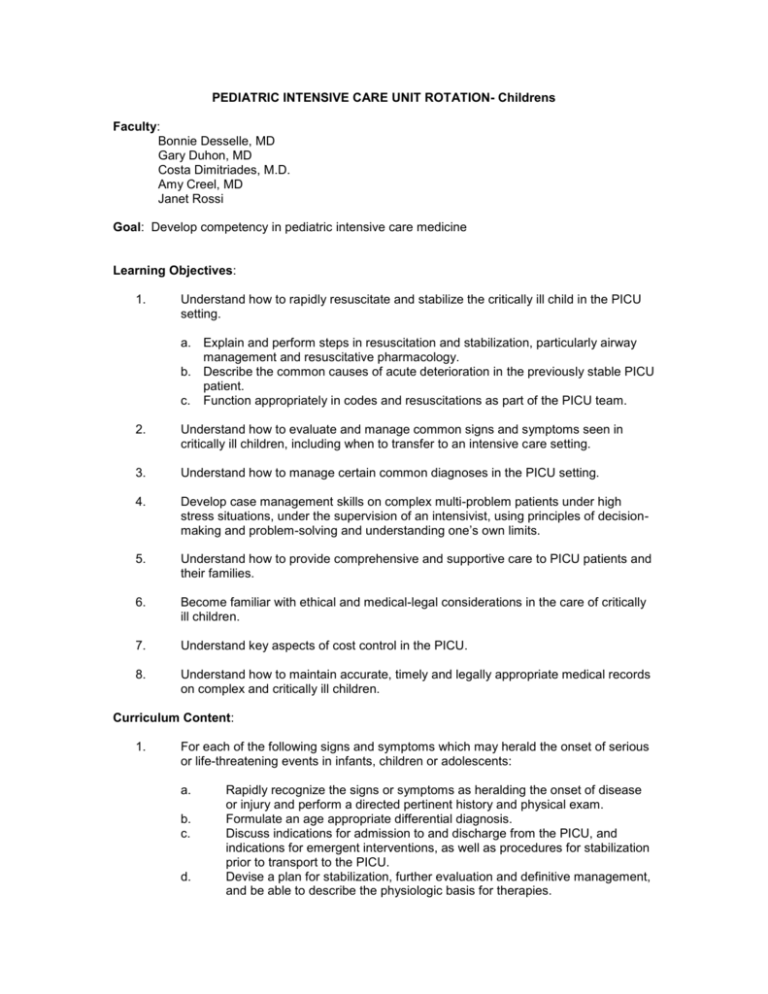
PEDIATRIC INTENSIVE CARE UNIT ROTATION- Childrens Faculty: Bonnie Desselle, MD Gary Duhon, MD Costa Dimitriades, M.D. Amy Creel, MD Janet Rossi Goal: Develop competency in pediatric intensive care medicine Learning Objectives: 1. Understand how to rapidly resuscitate and stabilize the critically ill child in the PICU setting. a. Explain and perform steps in resuscitation and stabilization, particularly airway management and resuscitative pharmacology. b. Describe the common causes of acute deterioration in the previously stable PICU patient. c. Function appropriately in codes and resuscitations as part of the PICU team. 2. Understand how to evaluate and manage common signs and symptoms seen in critically ill children, including when to transfer to an intensive care setting. 3. Understand how to manage certain common diagnoses in the PICU setting. 4. Develop case management skills on complex multi-problem patients under high stress situations, under the supervision of an intensivist, using principles of decisionmaking and problem-solving and understanding one’s own limits. 5. Understand how to provide comprehensive and supportive care to PICU patients and their families. 6. Become familiar with ethical and medical-legal considerations in the care of critically ill children. 7. Understand key aspects of cost control in the PICU. 8. Understand how to maintain accurate, timely and legally appropriate medical records on complex and critically ill children. Curriculum Content: 1. For each of the following signs and symptoms which may herald the onset of serious or life-threatening events in infants, children or adolescents: a. b. c. d. Rapidly recognize the signs or symptoms as heralding the onset of disease or injury and perform a directed pertinent history and physical exam. Formulate an age appropriate differential diagnosis. Discuss indications for admission to and discharge from the PICU, and indications for emergent interventions, as well as procedures for stabilization prior to transport to the PICU. Devise a plan for stabilization, further evaluation and definitive management, and be able to describe the physiologic basis for therapies. Signs and symptoms: 1. Cardiovascular: bradycardia, tachycardia, cardiopulmonary arrest, hypertension, hypotension, rhythm disturbances, poor capillary perfusion. 2. GI: abdominal distension, acute gastrointestinal hemorrhage, peritoneal signs, vomiting. 3. Hematologic: petechiae, purpura, polycythemia, anemia, neutropenia. 4. Neurologic: altered mental status, coma, delirium, encephalopathy, seizures, thermoregulatory abnormalities, acute weakness, tetany. 5. Renal: anuria, hematuria, oliguria, polyuria. 6. Respiratory: tachypnea, dyspnea, apnea, cyanosis, increased or decreased respiratory effort, poor air movement, stridor, wheezing, pulmonary edema. 2. For each of the following diagnoses which may require PICU monitoring and management: a. b. c. d. Discuss the pathophysiologic basis of the disease or injury. Discuss the indications for admission to and discharge from the PICU. Discuss stabilization, further work-up and management. Explain potential acute and long-term consequences and complications of the disease, and treatment and be able to evaluate prognosis. Common conditions: 1. General: submersion injury, shock (cardiogenic, hypovolemic, septic, toxic), burns (thermal, electrical), common intoxications. 2. Cardiovascular: congestive heart failure, pericardial effusion, cardiac tamponade. 3. Fluids, electrolytes, metabolic: severe dehydration, diabetic ketoacidosis, syndrome of inappropriate secretion of antidiuretic hormone, diabetes insipidus. 4. GI/surgery: stress ulcer, massive GI bleeding, abdominal trauma (blunt/penetrating), acute abdomen, pre-op and post-op management. 5. Hematologic: disseminated intravascular coagulopathy. 6. Neurologic: head injury acute increased intracranial pressure, cerebral edema, status epilepticus. 7. Pulmonary: adult respiratory distress syndrome, respiratory failure/impending respiratory failure, status asthmaticus, pneumothorax, upper airway obstruction (infectious, structural, foreign body). Skills Acquisition: 1. Laboratory and diagnostic tests: a. Explain the indications and limitations and be aware of age appropriate normals. b. Interpret abnormalities in the context of specific physiologic derangement. c. Discuss therapeutic options for corrections when appropriate. List of laboratory tests: 1. CBC, differential, platelets, indices 2. 3. 4. 5. 6. 7. 8. 9. 10. Blood chemistries: electrolytes, calcium, magnesium, glucose Tests of liver function and damage Renal function tests Arterial blood gases Coagulation studies, platelets, PT/PTT, fibrinogen, FSP, D-dimers, “DIC screen” Urinalysis CSF analysis Cultures and other diagnostic tests for infectious agents Drug levels and toxicologic studies List of imaging studies: 11. 12. 13. 14. 2. Chest x-ray Abdominal survey Cervical spine films CT scans Perform procedures: a. b. c. d. e. f. Intubation Arterial lines Central lines Lumbar punctures Pleuracentesis Chest tubes Reading Materials: Provided by faculty. Rotation Requirements: 1. 2. 3. 4. Residents will care for their patients under the supervision of an intensivist. Residents will pre-round on their patients daily and when on call. Residents will take call every fourth night. Residents will perform procedures with the supervision of faculty. PICU NOTES from EM Rotators: CODES Red Elevator rear door: 0607# All stairwells: 03* 4th floor call room: 3/5 (at same time), 4 GETTING THERE Children’s Hospital: 200 Henry Clay Ave Parking: Anywhere along the west side of the hospital by the baseball field, except spots labeled “ER Parking” PICU Access: Enter hospital thru ED entrance and take the RED elevators to 6th floor. Push 0607# on keypad then 6R. This will open directly into the PICU. If you can’t open rear door, you can get out on 6 and walk around the corner into the PICU. Prior to your first day make sure to watch the PICU video: http://www.youtube.com/watch?v=ltf49RhJoGA&feature=youtu.be DAILY SCHEDULE 7:00 am- Turn over rounds and assignment of patients in PICU doctor’s workroom. (To right of Red elevators) No need to arrive prior to 7am, but don’t be late 7:30- 9:00 am- See your patients and write notes 9:00 am- rounds with day Staff Noon- Noon Conference in second floor conference room (by blue elevators). Grab lunch prior, make sure to sign in for asynchronous learning credit 1:00- 4:00pm- check on patients, help with To-Do list, participate in staff teaching, dismissed per staff/on call resident 4:00 pm- Day staff checks out to Night staff and round on all patients. The on call resident participates in these rounds. The other residents can round if interested but usually leave at this time or earlier. CALL Don’t forget your pager! Most EM residents will have 3 overnight calls. The first two you will be paired with another peds resident, the final call will be solo. Staff is very involved and has to be called or texted for almost anything you do. Nurses require confirmation of faculty approval for most orders so don’t take it personally when they ask to see your text messages. Usually at the 4:00pm rounds you make plans and goals for the night on each pt. Goals are pretty specific for each patient so that there are very clear expectations and understanding of how to handle situations. (Such as: our goals for the ABG’s are PCO2 <60, increase rate by x amount to wean to those parameters. If febrile start these antibiotics at these dosages) During the night if those things happen you don’t have to call staff but if there are any unexpected changes or a nurse suggests whatever you are doing should be cleared by staff it is best to let them know. Staff is contacted first [before you] regarding any admissions and transfers. PICU Staff will then call you about the patient. Staff will generally come in for all admissions (especially when you are on!) You are responsible for writing a full H&P on admits but transfers or “consults” (i.e. neurosurgery is the primary service) just get an acceptance note. CALL ROOMS 4th floor by other call rooms. There is a PICU call room in the hallway of rooms. Bring earplugs and a blanket; it can be noisy and cold. POST CALL You will round on your patients first and then you break off to complete your duties, quickly check out to the on call resident, and leave, usually by 10:30. DOCUMENTATION / COMPUTER STUFF Daily notes: written on the PICU progress note page. Pre-printed you just fill in the details. Admits: document the H&P on the preprinted sheet Consults: when PICU isn’t primary or on the spine kids, just a blank consult note Transfer summaries: should be written at time of transfer on kids that the PICU is primary. Should also be written when you are leaving service for your patients that have been in the unit for >3 days. This gives oncoming residents a better idea of what has been happening. Other primary services: a lot of kids are surgery/neuro/ect primary. Those primary services are generally responsible for writing orders, transfers and discharges. Sorian: available on all of the computers. Have a peds resident help you add the Intensivist census to your list. This will have labs, vitals, I&Os for your morning notes. It also links to Raypax, the radiology software. PICU list: available on one computer in the resident room. Usually updated by the on call resident, just keep track of what should be changed for your patients FOOD The chief residents, Marci Houser and Emily Harrison, will get blue meal tickets to you on the 1st day. If not find them at conference or email them (addresses are in LSU webmail). Cafeteria is located on the 1st floor. There is Breakfast, Lunch, and dinner daily. The listed cafeteria prices are not the discounted resident price. The tickets are for up to $4.00. The actual cost of your food/amount of discount varies with the register lady so just be prepared with extra ticket or cash. Coffee is always free! NURSES/RESPIRATORY TECHS Most all are nice and very helpful. Inform them that you are one of the emergency medicine residents and they generally help out when you need anything. They are all aware of the daily plan and goals and work independently to help meet those goals TEACHING Some staff teaches more than others but all of their staff are very active in the residents’ education. It all depends on the number of patients on the unit, what needs done, and who staff is. The staff typically do all of the procedures and the peds residents don’t ask to do them. So if you see a procedure needs to be done, just step up and ask. I also would ask for the peds resident, “I can help Sarah put the central line in her patient” Because most of them haven’t done a central line or intubation. ORANGE BOOKLET The peds residents all have a handy laminated 8 card booklet. We will all share a book and this should be left in the workroom for the next EM resident on service. RANDOM PEDI ABBREVIATIONS BPD= bronchopulmonary dysplasia AGE= acute gastroenteritis CP= cerebral palsy HDSORA= hemodynamically stable on room air CBG= capillary blood gas
